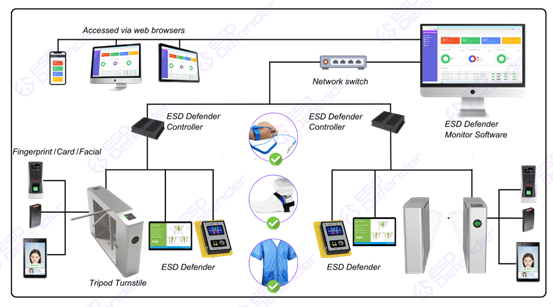Introduction: The Challenge of ESD Control in Busy Environments
In high-traffic manufacturing and laboratory facilities, maintaining consistent electrostatic discharge (ESD) protection is a significant challenge. Traditional wrist strap and footwear testing stations can create bottlenecks, while manual verification processes are prone to human error. ESD turnstiles provide an automated, efficient solution by integrating personnel grounding verification with access control. This article explores how these systems enhance static control while streamlining operations in demanding environments.
Table of Contents
How ESD Turnstiles Work: Automated Grounding Verification
ESD turnstiles function as smart entry gates that verify proper grounding before granting access:
1. Grounding Detection:
– Tests conductivity through footwear or wrist straps (via built-in plates or sensors)
– Validates resistance falls within ANSI/ESD S20.20 limits (typically <35Ω to 1MΩ for footwear)
2. Access Control Integration:
– RFID/NFC badges identify personnel
– Turnstile unlocks only after passing grounding verification
3. Data Logging:
– Records test results, timestamps, and employee IDs for compliance audits
Key Benefits Over Traditional ESD Control Methods
1. Eliminating Human Error in Testing
– Manual testing stations rely on employee compliance
– Turnstiles enforce 100% testing compliance with no bypass options
2. Reducing Congestion at Entry Points
– Processes workers in <3 seconds per person (vs. 15+ seconds for manual checks)
– Supports shift-change surges without queues
3. Real-Time Compliance Monitoring
– Instant alerts for failed tests via visual/audio signals
– Integrates with facility ESD monitoring software
Read more: Unlocking Business Success
Industry Applications: Where ESD Turnstiles Excel
Semiconductor Fabrication Plants
– Prevents wafer contamination from uncontrolled static
– Processes hundreds of technicians per shift
Medical Device Manufacturing
– Ensures ESD-safe entry to cleanrooms
– Tracks personnel access for FDA compliance
Aerospace & Defense Facilities
– Protects sensitive avionics during assembly
– Logs grounding data for military standards (MIL-STD-1686)
Critical Design Features for Optimal Performance
Key Features of Advanced ESD Test Stations
Modern ESD test stations are engineered for high precision, ease of use, and integration into larger electronic manufacturing systems. Here’s a closer look at the standout features that enhance reliability and operational efficiency:
1. Multi-Point Grounding Verification
Advanced testers support simultaneous testing of wrist straps and footwear, ensuring full-body grounding for personnel. This dual-point verification system helps:
- Detect improper strap usage, such as loose contact points or incorrect placement.
- Ensure both hands and feet maintain proper ESD connection when working in sensitive zones.
- Reduce human error and increase compliance with standards like ANSI/ESD S20.20.
This multi-point validation is critical in environments where precision and safety are non-negotiable—similar to how Time of Flight (ToF) cameras enhance real-time depth accuracy in automated systems by capturing detailed 3D spatial data.
2. Robust Construction Materials
High-performance testers are built using durable stainless steel or ESD-safe polymer housings that can withstand:
- Heavy use in industrial manufacturing plants
- Exposure to oils, static charges, and environmental stressors
- Frequent handling during shift changes or audits
These resilient materials ensure longevity, much like the durable casings and lenses used in ToF camera hardware for harsh environments like automotive or robotics industries.
3. Flexible Integration Options
Today’s ESD stations are more than just stand-alone testers. They’re designed for seamless integration into your facility’s digital infrastructure:
- Available as independent units or fully networked solutions
- API or software connectivity with ERP/MES systems for automated logging and alert generation
- Real-time data uploads to central dashboards, enhancing traceability and compliance
Just as ToF technology integrates with smart systems to enable gesture control, robotics vision, or AR interfaces, ESD testers now offer smarter operational control through digital connectivity.
Implementation Best Practices
1. Strategic Placement
– Install at all EPA entry points
– Position with queuing space for peak traffic
2. Employee Training Protocol
– Demonstrate proper positioning on test plates
– Explain alert signals and failure procedures
3. Maintenance Schedule
– Daily: Clean test plates with ESD-safe solution
– Monthly: Verify sensor calibration
– Annually: Full system inspection
ROI Analysis: Cost vs. ESD Incident Prevention
| Investment | Typical Cost | Savings |
|————|————-|———|
| Basic Turnstile | $5,000-$10,000 | Prevents 5+ ESD incidents/year ($50k+ in defects) |
| Advanced System | $15,000-$30,000 | Eliminates manual tester labor ($20k/year savings) |
| Full Integration | $50,000+ | Avoids compliance fines ($100k+) |
Emerging Innovations in ESD Turnstile Technology
1. AI-Powered Anomaly Detection
– Identifies gradual grounding degradation (e.g., worn shoe soles)
– Predicts maintenance needs
2. Touchless Biometric Verification
– Facial recognition + grounding scans
– Eliminates badge dependency
3. Mobile Integration
– Real-time alerts to supervisors’ devices
– Digital compliance reports
Conclusion: The Future of Automated ESD Control
ESD turnstiles represent a paradigm shift in static control, transforming personnel grounding from a manual checklist item into an automated, data-driven process. By combining rigorous testing with seamless access control, these systems:
– Reduce ESD risks more effectively than manual methods
– Improve operational efficiency in high-traffic facilities
– Provide auditable compliance with industry standards
As facilities embrace Industry 4.0, ESD turnstiles will become integral components of smart factory ecosystems. For organizations handling sensitive electronics, their implementation is no longer just an advantage—it’s a competitive necessity.
Considering ESD turnstiles for your facility? Consult with an ESD solutions provider to conduct a site assessment and traffic flow analysis.

